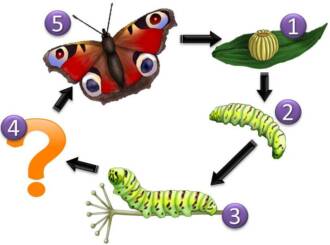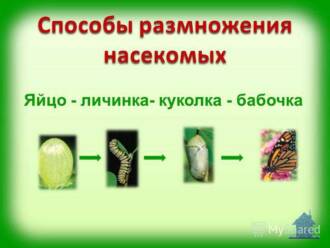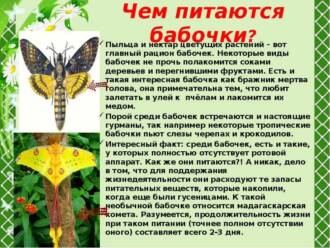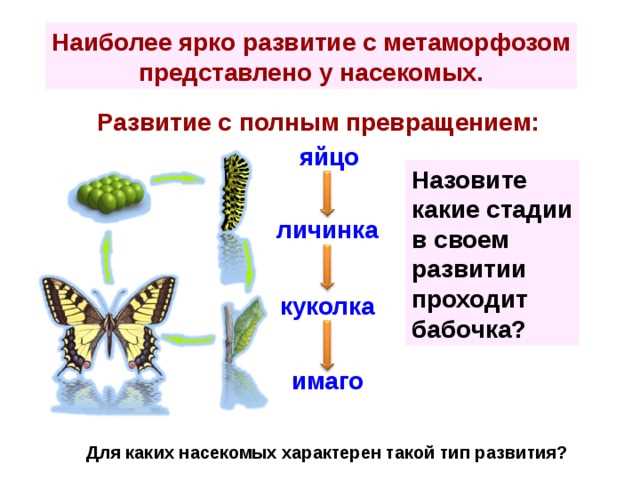
Metamorphosis is the amazing process of turning an egg into an adult butterfly that occurs in most insect species. It is one of the most fantastic phenomena of nature, striking in its beauty and complexity. During metamorphosis, significant changes occur in the external and internal structure of the insect, its organs and systems.
The process of metamorphosis occurs in several stages: egg, caterpillar (larva), pupa (diameter) and, finally, an adult. Each of these stages is distinguished by its unique features and adaptations to a particular lifestyle. For example, caterpillars have powerful jaws and feed on vegetation, while butterflies have wings and a proboscis designed to fly and suck nectar.
A feature of metamorphosis is that it occurs inside the pupa. A pupa is a specialized developed state in which the caterpillar's organs and tissues are rebuilt to become an adult butterfly. During this period, profound changes in the internal structure of the insect take place, the growth and development of all its organs, including wings and the reproductive system, take place.
Metamorphosis is an amazing process that allows insects to change their shape and structure in order to adapt to new living conditions. It is one of the most incredible and mysterious phenomena of nature, which scientists are still studying and trying to understand all its subtleties and features.
Egg metamorphosis: from a small creature to a beautiful butterfly
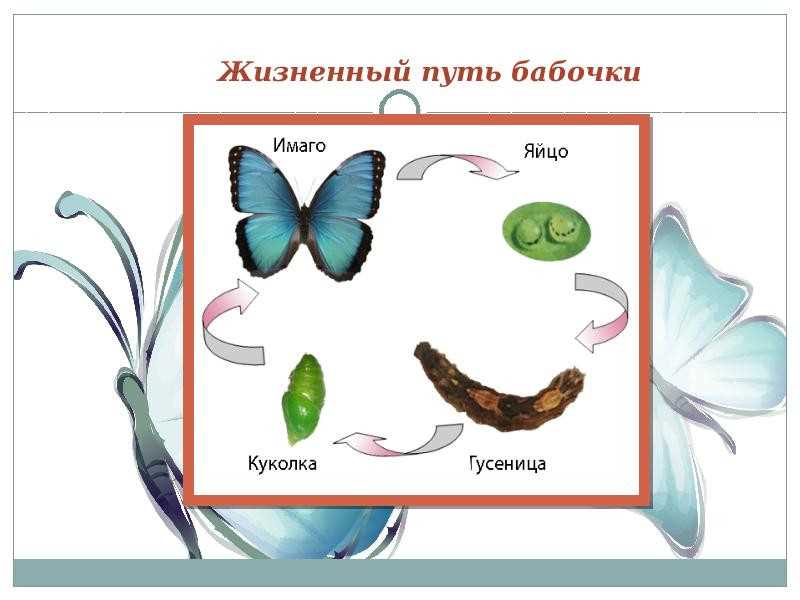
Egg metamorphosis is an exciting process that turns a small egg into a beautiful butterfly. This amazing process occurs in several stages, each of which has its own characteristics and physiological changes.
Stage 1: A caterpillar emerges from the egg
After fertilization, the egg develops and a caterpillar emerges. The caterpillar is a small creature that feeds on leaves and grows actively. During this stage, the caterpillar goes through several molts, during which it sheds its outer shell and grows a new, larger one. The caterpillar is also active in searching for a suitable place for its next stage of development.
Stage 2: The caterpillar turns into a chrysalis
Once the caterpillar reaches a certain size, it stops feeding and begins building its protective cocoon, the pupa. The pupa is formed from the outer layer of the caterpillar, which is rejected, and complex internal changes occur underneath. Inside the pupa, the caterpillar's tissues and organs are transformed into new structures necessary for the future state of the butterfly.
Stage 3: The butterfly hatches from the chrysalis
After several weeks of being inside the chrysalis, the butterfly is ready to hatch. She destroys her chrysalis and goes outside. At first she looks soft and weak, but soon her wings begin to unfurl and take hold. The butterfly spends time drying its wings and gaining strength for flight. Soon she is ready for her first flight and begins to explore the environment in all its beauty.
Thus, the metamorphosis of an egg into a beautiful butterfly is an amazing and complex process that demonstrates the magnificence of nature and its ability to transform and evolve. This process reflects the uniqueness and beauty of each living being, and allows us to see how a small egg can turn into a beautiful and elegant creature capable of flying to distant places.
Stages of development and transformation
The process of turning an egg into a butterfly goes through several stages of development, each of which has its own characteristics and physiological changes.
1. Egg
The first stage of development is the egg, which is the initial stage of the butterfly's life cycle. The egg has a strong shell and contains all the necessary nutrients for the development of the future organism.
2. Caterpillar
After hatching from the egg, the butterfly is in the caterpillar stage. The caterpillar has a small body and many legs. She actively feeds and grows, passing through several molts, on each of which she changes her appearance and size. At this stage, the caterpillar gains the necessary energy and reserves for the next stage.
3. Pupa
After reaching a certain size, the caterpillar begins the process of turning into a chrysalis. The pupa is a dormant developmental stage in which significant changes in the internal anatomy and structure of the caterpillar occur. Outwardly, the chrysalis may look like an immovable object, but inside there are complex processes of transformation of organs and tissues.
4. Butterfly

And finally, the last stage is the butterfly emerging from the chrysalis. After the metamorphosis is complete, the butterfly emerges from the chrysalis as an adult and ready for independent life. It has wings that allow it to fly and a proboscis with which it feeds on flower nectar.
- Egg
- Caterpillar
- chrysalis
- Butterfly
This whole process of development and transformation is incredibly amazing and unique in the world of insects. It demonstrates the continuous cycle of life and symbolizes transformation and growth.
Survival adaptations
The process of metamorphosis from egg to butterfly is complex and physiologically unique. One of the main adaptations for survival at various stages of this process is the protective shell of the egg.
The butterfly egg has a tough shell that protects it from external factors such as cold, moisture and predators. In addition, this shell provides the necessary moisture and nutrients for the development of the embryo.
At the next stage - the larva - the main adaptation is the ability to actively feed in order to gain enough food for growth and development. Butterfly larvae usually have specialized jaws or other organs that enable them to chew and process food such as leaves or flowers.
When the larva reaches a certain size, it passes into the next stage - the pupa. The pupa has a special adaptation - a slimy cocoon or hard shell that protects it from the external environment and provides the necessary moisture and nutrients to develop into an adult butterfly.
The adult butterfly has a number of survival adaptations, including the ability to fly to search for food and a breeding mate. They also have compound eyes that allow them to see across a wide spectrum and distinguish colors and shapes.
Physiology of the process

The metamorphosis of an egg into a beautiful butterfly is a complex and amazing process that occurs due to physiological changes in the body. It includes several stages, in each of which certain changes occur.
The first stage is the development of the egg. Inside the egg is an embryo that gradually develops. At this moment, cell division and the formation of the main organs and body systems of the future butterfly take place.
This is followed by the second stage, the larval stage. The larva hatches from the egg and begins active growth. It feeds on plant foods and gradually increases in size. At this time, the formation of the main organs and tissues necessary for the further life of the butterfly takes place.
The third stage is the pupal stage. After reaching a certain size, the larva stops feeding and turns into a pupa. Complex physiological processes take place inside the pupa: the tissues and organs of the larva are destroyed, and in their place new ones, characteristic of the butterfly, are formed.
Finally, the fourth stage comes - the stage of the imago, or adult butterfly. A fully formed insect emerges from the pupa. He has wings, eyes, antennae and other organs. The butterfly is ready to fly and performs its main function - reproduction.
Unique Features
The process of metamorphosis of an egg into a beautiful butterfly is unique and exciting. It takes place in several stages, each of which has its own characteristics.
Change in shape and structure
The first unique feature of metamorphosis is the change in the shape and structure of the organism. Initially, the egg has a round or oval shape, but after fertilization, active development begins. As a result, there is a gradual transformation of the egg into a caterpillar, and then into a chrysalis, inside which amazing changes take place. As a result, a beautiful butterfly with wings comes out of the chrysalis, ready to fly.
Change in organ functions
The second unique feature is associated with a change in the functions of organs in the process of metamorphosis. The caterpillar, feeding on leaves, actively grows and accumulates nutrients. When it's time to turn into a chrysalis, she stops feeding and begins to form a cocoon or caterpillar house. Inside the pupa, complex developmental processes take place, as a result of which the organs of the caterpillar change and new organs appear that are necessary for the life of the butterfly.
Thus, the metamorphosis of an egg into a butterfly is a unique process that combines a change in the form, structure and functions of the body. This process is one of the most amazing and mysterious in the animal world.
Environmental influence
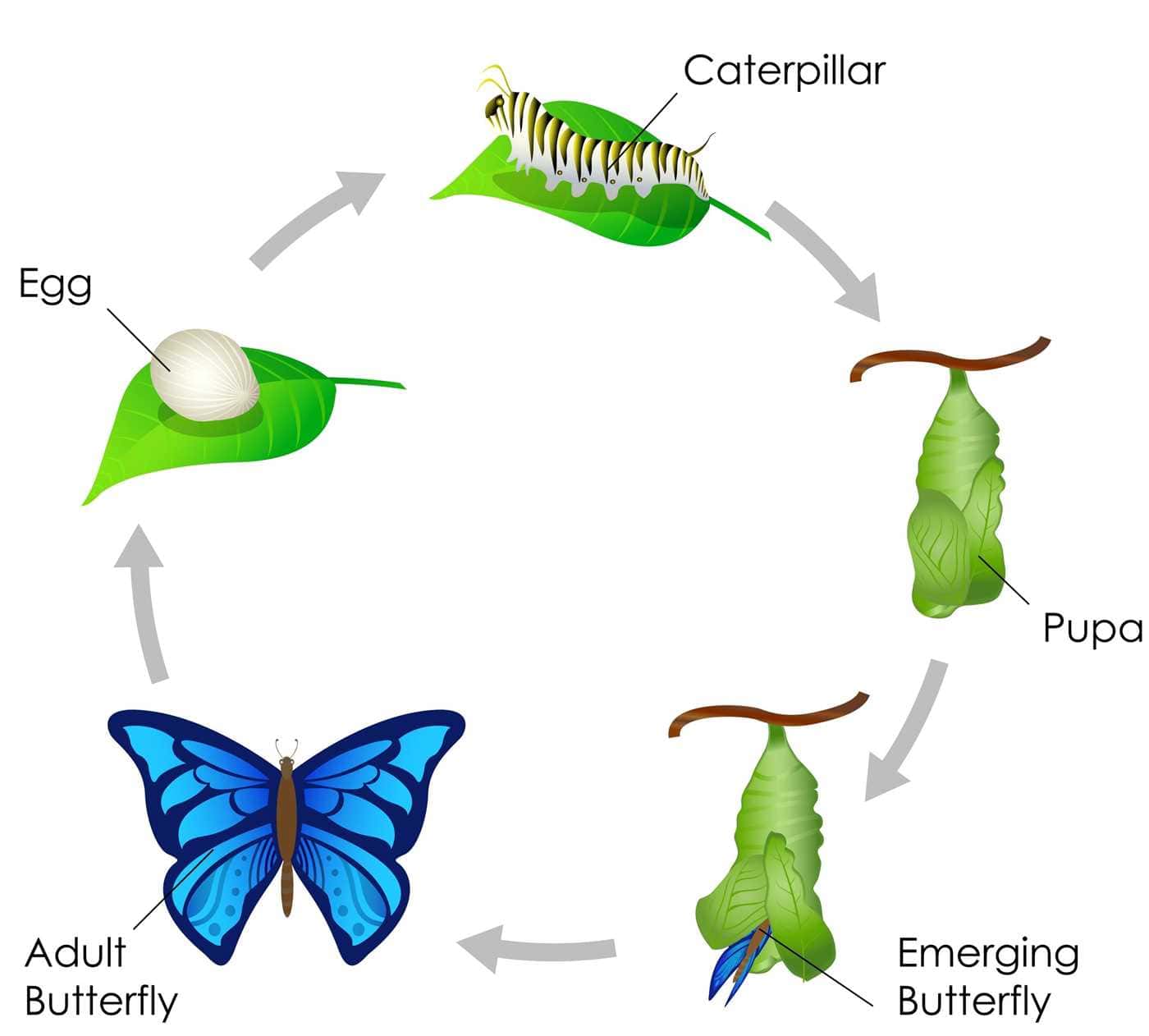
The environment plays an important role in the process of egg metamorphosis into a butterfly. Each stage of insect development requires certain conditions that are provided by the environment. Factors such as temperature, humidity, food availability and light have a direct effect on the development and survival of the egg, caterpillar and pupa.
Temperature plays a key role in metabolic processes and regulation of insect development. The optimal temperature for egg and caterpillar development may vary depending on the butterfly species. Low temperatures can retard development, while high temperatures can lead to death. Humidity is also important for successful development as it affects metabolism and keeps the body hydrated.
The availability of food is an essential factor in the development of a butterfly. Caterpillars feed on plant materials and it is essential that their food is available in sufficient quantity and quality. Some butterfly species have specialized host plants that are the only source of food for the caterpillars. Without these plants, caterpillars will not be able to survive and successfully pass the stage of pupa and subsequent transformation into a butterfly.
Light also plays an important role in the development of butterflies. It affects the seasonality of development, the direction of movement of the caterpillar and the formation of colors on the wings of butterflies. Some species of butterflies brighten in direct sunlight, which helps them camouflage against the background of the environment.
So, the environment has a significant impact on the process of egg metamorphosis into a beautiful butterfly. Optimal conditions of temperature, humidity, availability of food and light ensure the successful development of the insect and its survival in nature.
Internal changes
The process of metamorphosis of an egg into a beautiful butterfly is amazing and complex. It includes a number of internal changes that occur inside the egg and allow it to develop into a full-fledged insect.
One of the key changes that take place inside the egg is the formation and development of the organs of the future butterfly. Inside the egg, a head, thorax and abdomen, as well as legs and wings, begin to develop. All these organs are formed as the larva develops and are preparing to go outside.
In addition to the formation of organs, other important changes occur inside the egg. For example, the process of converting the food that is inside the egg into the energy and nutrients necessary for the development of the future butterfly begins.
Also inside the egg, the growth and development of the larva takes place. She actively feeds and grows, using the food reserves inside the egg. In the process of development, the larva undergoes a series of internal transformations that allow it to turn into a pupa.
In general, the internal changes that occur in the egg during metamorphosis are a complex and fascinating process. They allow the egg to develop into a full-fledged butterfly and provide it with everything it needs to survive and reproduce.
The role of hormones

Hormones play an important role in the process of egg metamorphosis into a beautiful butterfly. They regulate all stages of development, from the egg to the adult form. Hormones affect the growth and differentiation of cells, accelerate or slow down metabolic processes.
One of the main hormones involved in metamorphosis is ecdysteroids. They stimulate the growth and development of butterfly organs and tissues, and also contribute to the formation of wings and reproductive organs.
Another important hormone is juvenile hormone. It controls the intermediate stages of development such as larva and pupa. The juvenile hormone suppresses the processes of metamorphosis and ensures the preservation of the larva until the moment when it is ready to turn into a pupa.
Also, hormones play an important role in regulating the time and rate of metamorphosis. They determine when to start and complete each stage of development. For example, hormones can signal the need to start developing wings or forming sex organs.
In general, hormones are key regulators of the process of metamorphosis, ensuring the consistent and coordinated development of the butterfly from egg to adult.
duration of metamorphosis
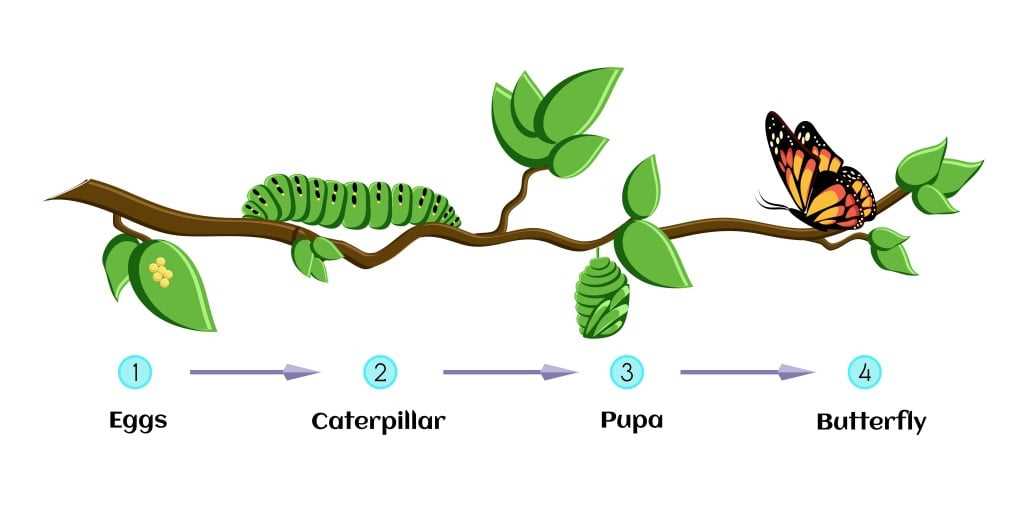
The process of metamorphosis of an egg into a beautiful butterfly is amazing and fascinating. It occurs in several stages and takes a certain time.
Stages of metamorphosis
The first stage is the hatching of the caterpillar egg. This happens depending on the type of butterfly and can take anywhere from a few days to a few weeks. The caterpillar begins to actively feed in order to gain enough nutrients for the next stage.
The second stage is the formation of the pupa. The caterpillar stops feeding and looks for a suitable place to create a cocoon or caterpillar nest. Inside the cocoon, amazing changes occur in the body of the caterpillar. It turns into a chrysalis, inside which the transformation of tissues and organs takes place.
The third stage is the hatching of the butterfly from the chrysalis. This is a process that can take anywhere from a few days to a few weeks. A new butterfly emerges from its cocoon and spreads its wings. She must wait until her wings are dry and strong before she can take off and start her new life.
duration of metamorphosis
The duration of metamorphosis may vary depending on the butterfly species and environmental conditions. Usually the whole process from an egg to a full-fledged butterfly takes from several weeks to several months. However, some species of butterflies can go through metamorphosis for a longer time.
It is interesting to note that the time taken for each stage of metamorphosis can also depend on the ambient temperature. A warm environment can speed up the process, while a cold environment can slow it down.
Thus, the time it takes for an egg to metamorphose into a beautiful butterfly is variable and depends on many factors, including butterfly species, environmental conditions, and temperature. However, regardless of the duration, the process of metamorphosis itself remains an amazing natural phenomenon that delights and inspires.



